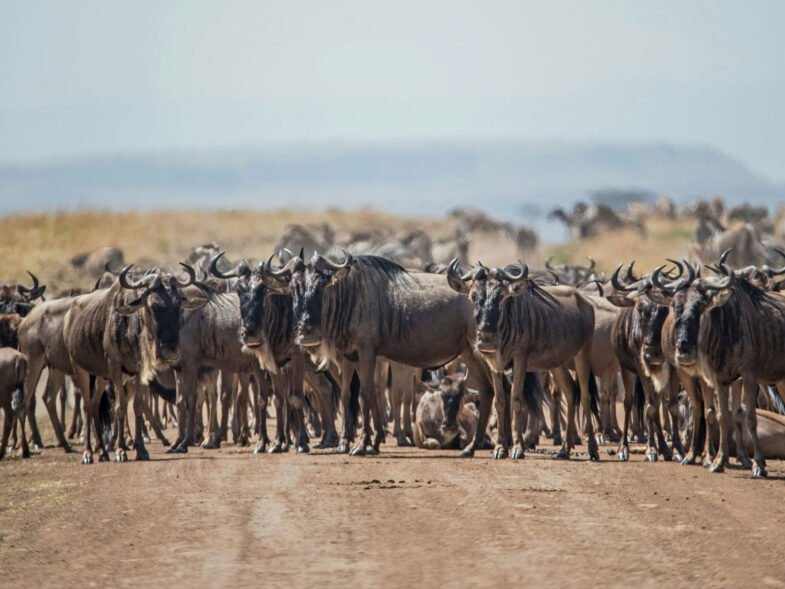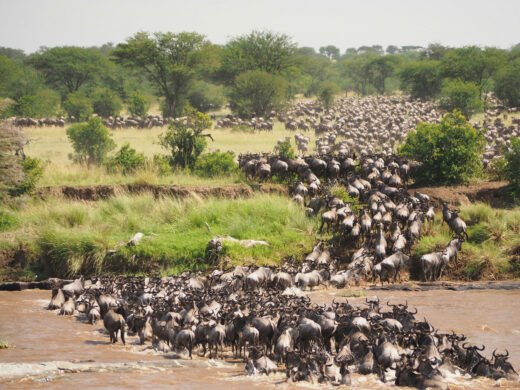Discover the Spectacular Serengeti Wildebeest Migration
The wildebeest migration is one of the most spectacular wildlife events in the world, occurring annually in the Serengeti ecosystem between Tanzania and Kenya

Serengeti Wildebeest Migration
The Serengeti Migration is a breathtaking natural spectacle that occurs annually in Serengeti National Park. This world-renowned event captivates millions of tourists from around the globe, making it a major attraction for the tourism and hospitality industries. One of the most famous migrations takes place between the Tanzanian Serengeti and the Kenyan Maasai Mara National Reserve, passing through the Mara River east of the Grumeti River and through Lobo.
Often referred to as the "world cup of animals," the Serengeti Wildebeest Migration sees millions of wildebeests and zebras making their way across the Mara River into the Maasai Mara National Reserve. The river serves as the stadium for this natural spectacle, with crocodiles acting as referees by preying on the animals as they cross.
In addition to the migration, the Serengeti National Park offers excellent wildlife viewing opportunities throughout the year. Areas like Seronera, Grumeti River, and Ndutu are known for their abundant wildlife, including a high concentration of cheetahs. The wildebeest migration occurs in five sectors or regions of the park, each at different times of the year, solidifying Serengeti National Park as one of Africa's premier destinations.
Experience the thrill of the Serengeti Migration and witness the wonders of the natural world in action. Embrace the beauty and power of nature as you witness this incredible event unfold in the heart of Serengeti National Park.

Throughout the year, Serengeti National Park offers excellent wildlife viewing opportunities, particularly in areas like Seronera, Grumeti River, and Ndutu. The wildebeest migration occurs in five sectors or regions of the park, each at different times of the year, cementing Serengeti National Park as one of Africa's top destinations, consistently voted as such several times.
The Great Wildebeest Migration is one of the most spectacular wildlife events on the planet, attracting thousands of travellers each year to witness this awe-inspiring spectacle in the heart of Africa. Here's your ultimate guide to experiencing the Wildebeest Migration Safari:
Everything You Need to Know About the Serengeti Wildebeest Migration
The Serengeti Wildebeest Migration is a breathtaking natural phenomenon, featuring millions of wildebeest, zebras, and other grazers moving across the Serengeti ecosystem in East Africa. If you're fascinated by wildlife and nature, read on to discover the answers to some frequently asked questions about this awe-inspiring event.
What is the Serengeti Wildebeest Migration?
The Serengeti Wildebeest Migration is a mesmerizing spectacle where millions of wildebeest, accompanied by zebras and other grazers, traverse the Serengeti ecosystem in East Africa.
Can the Serengeti Wildebeest Migration River Crossings be Predicted?
Predicting the exact timing and location of river crossings during the Wildebeest Migration can be challenging due to various factors such as weather conditions, water levels, and the movement of the herds. However, experienced guides and tour operators often have a good understanding of the migration patterns based on historical data and local knowledge. They can provide insights and increase the chances of witnessing these dramatic river crossings during your safari.
When does Seregeti Wildebeest migration occur?
While the migration is a year-round event in search of water and fresh grazing grounds, the most exhilarating phases happen from June to August in the Mara River region and from December to March in the southern Serengeti plains during calving.
What routes do the wildebeest take during the migration?
The migration follows a circular path of about 1,800 miles, moving clockwise from the southern Serengeti plains in Tanzania to the Maasai Mara National Reserve in Kenya and back.
What predators are involved in the migration?
Predators like lions, cheetahs, leopards, and crocodiles play a crucial role in the migration, hunting the weaker animals as they cross the savannah and rivers.
How many wildebeest are involved in the migration?
Estimates suggest that over 1.5 million wildebeest, along with hundreds of thousands of zebras and other herbivores, partake in the migration.
What are the highlights of the migration?
Some of the highlights include the thrilling river crossings where thousands of wildebeest face crocodiles and the calving season in the southern Serengeti, with hundreds of thousands of calves born.
How can I witness the migration?
Various safari tours are available year-round along the migration route, with camps and lodges strategically placed for optimal viewing. Plan your visit based on the migration phase you wish to see.
What should I pack for a safari during the migration?
Pack essentials like lightweight clothing, a hat, sunscreen, insect repellent, sturdy shoes, binoculars, a camera, and any necessary medications for a comfortable and unforgettable safari experience.
Is the migration affected by climate change or human activity?
Climate change and human actions like deforestation and infrastructure development can impact migration patterns, grazing lands, and the overall ecosystem's health.
Is the Serengeti Wildebeest Migration a once-in-a-lifetime experience?
While witnessing the migration is incredible, many visitors are drawn back to the Serengeti multiple times due to its ever-changing nature and the stunning beauty of the natural world in motion.
Additional Tips for a Serengeti Wildebeest Migration Safari:
Book in Advance: The Wildebeest Migration is a popular safari experience, so it's advisable to book your safari well in advance to secure the best accommodations and guides.
Choose the Right Time: Aim to visit during the peak migration months (July to October) for the best chance of witnessing river crossings and large herds of animals.
Follow the Herds: Since the migration is constantly on the move, consider a safari itinerary that allows flexibility and follows the movements of the herds.
Pack Accordingly: Prepare for various weather conditions by packing appropriate clothing and gear, including binoculars and a good camera to capture the incredible wildlife moments.
Here's a month-by-month guide to the Serengeti Wildebeest Migration:
January to March (Calving Season):
The year begins with the wildebeest herds congregating in the southern Serengeti plains of Tanzania. January sees the start of the calving season, where hundreds of thousands of wildebeest give birth within a short period. Predators like lions, cheetahs, and hyenas are active during this time, preying on the vulnerable young calves.
April to May (Transition):
As the rains diminish and the grasslands become dry, the herds start to move northwestward. The migration usually moves towards the Western Corridor, with some herds crossing the Grumeti River in Tanzania. This period is characterized by a transitional phase as the herds gradually move towards the next stage of their journey.
June to July (Grumeti River Crossing):
By June, the wildebeest migration reaches the Grumeti River, where dramatic river crossings occur. Wildebeests must navigate through crocodile-infested waters, and many fall victim to these predators during the crossings. The river crossings are one of the most iconic and thrilling events of the migration, attracting tourists and photographers from around the world.
August to October (Northern Serengeti & Masai Mara):
As the dry season progresses, the herds continue their northward journey into the northern Serengeti and eventually cross into Kenya's Masai Mara Reserve. The Mara River crossings in Kenya are another highlight of the migration, similar to those at the Grumeti River. This period offers excellent opportunities to witness predator-prey interactions, as lions, cheetahs, and other predators hunt the migrating wildebeests.
November to December (Return to Southern Serengeti):
As the short rains begin, the wildebeest migration starts its return journey towards the southern Serengeti plains. The cycle repeats itself as the herds gather once again for the calving season, marking the completion of a full migration cycle.
Something else to inspire
The tours below showcase just some of what is possible; use these itineraries as starting points,or to draw inspiration . You can reduce or add days and/or destinations and change to whatever accommodation your prefer
Then get in touch, and let our expert team help craft the perfect
itinerary for you
Tanzania Safari Holidays
Are you ready to start on the adventure of a lifetime with the best Tanzania safari holidays, Serengeti safaris, and Kilimanjaro trekking experiences?
